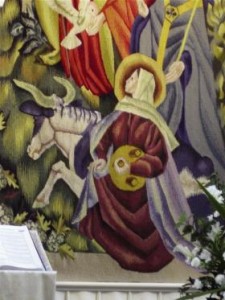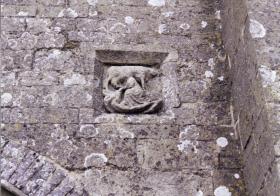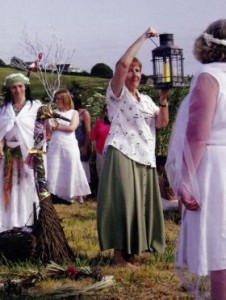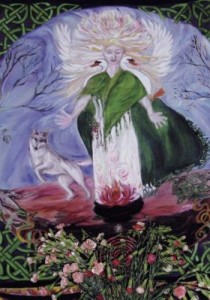Did St Brigid visit Glastonbury?
Published in Features, Issue 1 (Jan/Feb 2010), Pre-Norman History, Volume 18
St Brigid is still venerated and celebrated in the Glastonbury area. This 1965 tapestry, designed by Brother Louis Barlow of the Benedictine Abbey, Prinknash, Gloucestershire, today hangs behind the altar in St Mary’s Catholic Church, Glastonbury.
Brigid, goddess and saint, the second most important Irish saint after Patrick, is well known not only in Ireland but also in many other parts of the world. Thousands of books and articles have been written about this influential figure since the first by Cogitosus c. AD 650. Yet some historians have claimed she did not even exist! Brigid is unique in still being venerated not only as a saint but also as a goddess.
William of Malmesbury and John of Glastonbury
There is a long-standing belief that St Brigid visited Glastonbury, Somerset, in AD 488, first noted in The history of the kings of Britain by William of Malmesbury c. 1120:
‘Wherefore the report is extremely prevalent that both Saint Indract and Saint Brigid, no mean inhabitants of Ireland, formerly came over to this spot. Whether Brigid returned home or died at Glastonbury is not sufficiently ascertained, though she left here some of her ornaments; that is to say, her necklace, bag, and implements for embroidering, which are yet shown in memory of her sanctity, and are efficacious in curing divers diseases.’
William of Malmesbury later wrote a history of its abbey, An enquiry into the antiquity of the church at Glastonbury, between 1129 and 1139, but there are slight variations of the story in different editions of William’s work, the earlier one reading:
‘Hence the custom developed among the Irish of visiting that place to kiss the relics of their patron. Whence the well known story that Saint Indract and the Blessed Brigid, prominent citizens of that land, once frequented the place. They say that after Saint Brigid, who had come there in 488 AD, had tarried for some time on the island called Beokery [Beckery] she returned home but left behind certain of her ornaments, namely a bag, necklace, a small bell and weaving implements, which are still preserved in memory of her.’
 A later edition does not record her date of arrival at Beckery, near Glastonbury, either because William or the copyist may have considered it irrelevant or because there were doubts about it:
A later edition does not record her date of arrival at Beckery, near Glastonbury, either because William or the copyist may have considered it irrelevant or because there were doubts about it:
‘Hence Irish pilgrims came to the spot. Saint Brigid dwelt long in the island of Beokery and, returning home, left memorials of wonder-working power.’
St Brigid’s stay at Beckery was also related by John of Glastonbury in The chronicle of the ancient church at Glastonbury, c. 1340:
‘Saint Brigid made a stay of several years on an island near Glastonbury, called Bekery or Little Ireland, where there was an oratory consecrated in honour of Saint Mary Magdalene. She left there certain signs of her presence—her wallet, collar, bell, and weaving implements, which are exhibited and honoured there because of her holy memory—and she returned to Ireland, where, not much later, she rested in the Lord and was buried in the city of Down. The chapel on that island is now dedicated in honour of Saint Brigid; on its south side there is an opening through which, according to the belief of the common folk, anyone who passes will receive forgiveness of all his sins.’
The chapel in which St Brigid is said to have stayed was dedicated to St Mary Magdalene, although one local tradition says that St Brigid founded it.
‘Glastonbury of the Gaels’

Sister Mary Minehan, a Brigidine nun, holds the perpetual flame brought from their house at Kildare in Ireland to Bride’s Mound, Beckery, where a special garden was built to honour the goddess Brigid in 1994.
The ninth-century Sanas Cormac (Cormac’s Glossary) of Bishop Cormac mac Cuilleanáin refers to ‘Glasimpere of the Gadhaels’ (Glastonbury of the Gaels), suggesting the strong link between Glastonbury and Ireland even at that time. There were many connections between Glastonbury and Ireland, with Irish monks based at the abbey, which had extensive land-holdings in Ireland from the twelfth century. In the thirteenth century Archbishop Henry de Loudres of Dublin and other Anglo-Norman bishops granted indulgences to Irish pilgrims to Glastonbury, absolving them from their sins if they undertook a visit to this holy site. By this period Glastonbury had long been on the Irish pilgrim’s route to the Continent. Travellers crossed from Wexford or Waterford to Bridgwater Bay in the Bristol Channel, up the River Parrett to Bridgwater, then along the pilgrims’ route to Glastonbury. This took them along an ancient road running eastwards on top of a long ridge on the Polden Hills or along the River Brue to land at Beckery. After the pilgrims had visited Beckery chapel and Glastonbury Abbey, they continued their pilgrimage via Salisbury, Winchester and Canterbury, then across the Channel to visit holy sites on the Continent. Somerset has three churches besides Beckery that have St Brigid as their patron saint. A calendar in the Bosworth Psalter is derived from the Calendar of Glastonbury. Among the saints especially commemorated in this is St Brigid, which shows her special veneration at Glastonbury perhaps as early as the 930s.
St Brigid’s chapel at Beckery had disappeared by the mid-nineteenth century, but the site was excavated in 1887–8 by John Morland, who uncovered the remains of two chapels, one within the other. Just north of the chapel he found a priest’s house. A more extensive excavation carried out by Philip Rahtz in 1967–8 clarified the history of the site. The first chapel, which survived as post-holes and timber slots, was 6m long, with an interment radiocarbon-dated to AD 650–810. A small religious community was settled at Beckery; dating evidence indicates that it was founded in the early Saxon period, perhaps shortly after 670, when Beckery was given back to the abbey by King Cenwealh. This early chapel was surrounded by a cemetery containing the remains of 63 individuals. Although the abbey and Beckery chapel adopted the practices of the Roman church from the seventh century, they never ceased to be a centre for Celtic pilgrimage. Both played an important part in reconciling the Celtic and Roman churches, particularly after Beckery chapel was rededicated to St Brigid.
Around 1000 the cemetery went out of use and the wooden chapel was replaced by a building 11m long and 6m wide, built of local blue lias stone with ashlar around the doors and windows. There were two doors in the stone chapel, both on the north side of the building, but on the south side there was a covered staircase to an upper gallery, which is where the relics of St Brigid were kept. Pilgrims would have been admitted to pray in the presence of the relics. When this second chapel was built, the monastic community on the site was discontinued and the chapel was attended by one or two priests (ordained monks) living in a timber building to the north of it. About 1290 this chapel was totally rebuilt and enlarged for the third time in a typical medieval pattern, and was now 15m long and 7m wide.
Origin of the story?
The local tradition that St Brigid visited Beckery is as strong today as it was when first noted by William of Malmesbury over 880 years ago, and many people still visit the site where the chapel stood. So is it possible to discover the origin of this story? Brigid was a real person, a member of the Fothairt family, who founded a Christian religious establishment at Kildare around 470 and whose generally accepted date of death was c. 525. The written stories about her visit and stay in Somerset only date from c. 1120 in the earliest surviving source, however, and the date for her visit, 488, is first recorded around 1129–39, but with no other authority than ‘they say . . .’.
This suggests that it came from a local tradition at Glastonbury Abbey, which at that point had kept the relics ‘left by the saint’ for over 120 years in Beckery chapel. There is no supporting evidence for St Brigid’s visit to Somerset in early Irish sources, and the first Irish writers to mention her visit to Glastonbury were Archbishop James Ussher (1581–1656) in his Chronological index and John Colgan in his Trias thaumaturga (‘The miracle works of saints’, 1647). Brigid, as abbess of the important double monastery at Kildare, would have travelled widely in Ireland, but it seems very unlikely that she actually visited Somerset. What is certain is that about 400 years after St Brigid’s death there was extensive contact between Somerset and Ireland, with many Irish monks both visiting Glastonbury and being based there.
The original dedication to St Mary Magdalene had been changed by 1340 to St Brigid in honour of her alleged visit. The most likely time for this rededication was when the wooden chapel was replaced by the larger stone building around 1000. The replacement of the first wooden chapel by a more impressive stone structure could indicate the increasing importance of the site owing to the story that the saint had spent time there. John of Glastonbury, however, says that when St Brigid left Beckery for Ireland she left behind certain articles which were ‘. . . honoured there because of her holy memory’, and it is probable that the stone chapel was built to house them. This would have been an appropriate time to rededicate the chapel to the saint whose relics were displayed there. These remained objects of veneration in Beckery chapel until Glastonbury Abbey was dissolved by Henry VIII in 1539, when they disappeared. The relic bell, however, was rediscovered in 1913.
If St Brigid herself didn’t bring the relics, who did?

A painting of Brigid in the Goddess Temple, Glastonbury, a registered place of worship where ceremonies to honour the goddess Brigid are held.
The small monastery at Beckery probably consisted mostly of Irish monks, who would have been keen to see a chapel dedicated to an Irish saint there, particularly as Beckery was the first place that Irish and other pilgrims encountered when approaching Glastonbury from the west. There is no doubt that this second chapel at Beckery did house relics of St Brigid. In view of the importance placed on saints’ relics in the early medieval period, and particularly of items that were reputed to have belonged to this second most important Irish saint, they would have been brought to St Brigid’s chapel by a senior member of the church. The most obvious candidate would be the abbess of St Brigid’s monastery at Kildare. The abbess of Kildare from 979 until 1016, the period when the second chapel at Beckery was built, was Eithne ingen Ui Suairt, whose official title was Comarba Brigte (‘successor to Brigid’). She was also a member of the Ui Chulduib branch of the Fothairt, the family to which St Brigid herself belonged. Following the visit and gift of St Brigid’s relics to the chapel by Abbess Eithne, the account of this event may have become distorted over time, so that the ‘successor of Brigid’ and an actual descendant of St Brigid, who was also a Brigidine nun, became confused with the saint herself. Thus by the time that William of Malmesbury was writing around 1120 the monks and local people had convinced themselves that St Brigid had actually visited Beckery.
Brigid is still venerated and celebrated in ceremonies regularly held at the site of Beckery chapel, as a goddess by pagans and as a saint by Christians. So Brigid continues to be a bridge between the past and the present and between the pagan and Christian worlds, as she was during her lifetime. HI
Brian Wright is a West Country archaeologist, folklore historian and tour guide.
Further reading:
J. Carley, Glastonbury Abbey: the Holy House at the Head of the Moors Adventurous(Glastonbury, 1996).
P. Rahtz, The English Heritage Book of Glastonbury (London, 1993).
J. Scott, The early history of Glastonbury: an edition, translation and study of William of Malmesbury’s De Antiquitate Glastoniensis Ecclesia (Woodbridge, 1981).
B. Wright, Brigid: goddess, druidess and saint (Stroud, 2009).
















